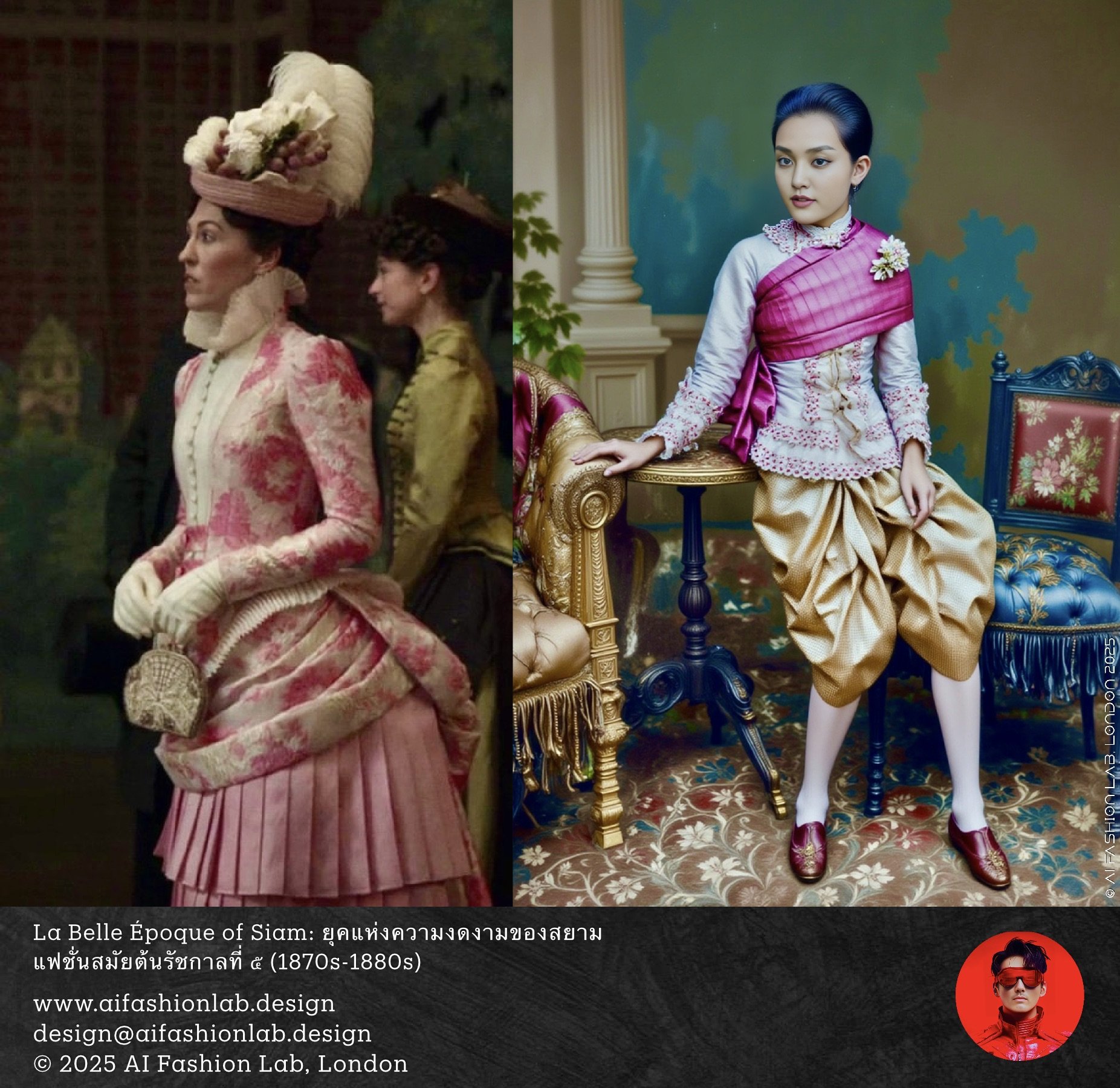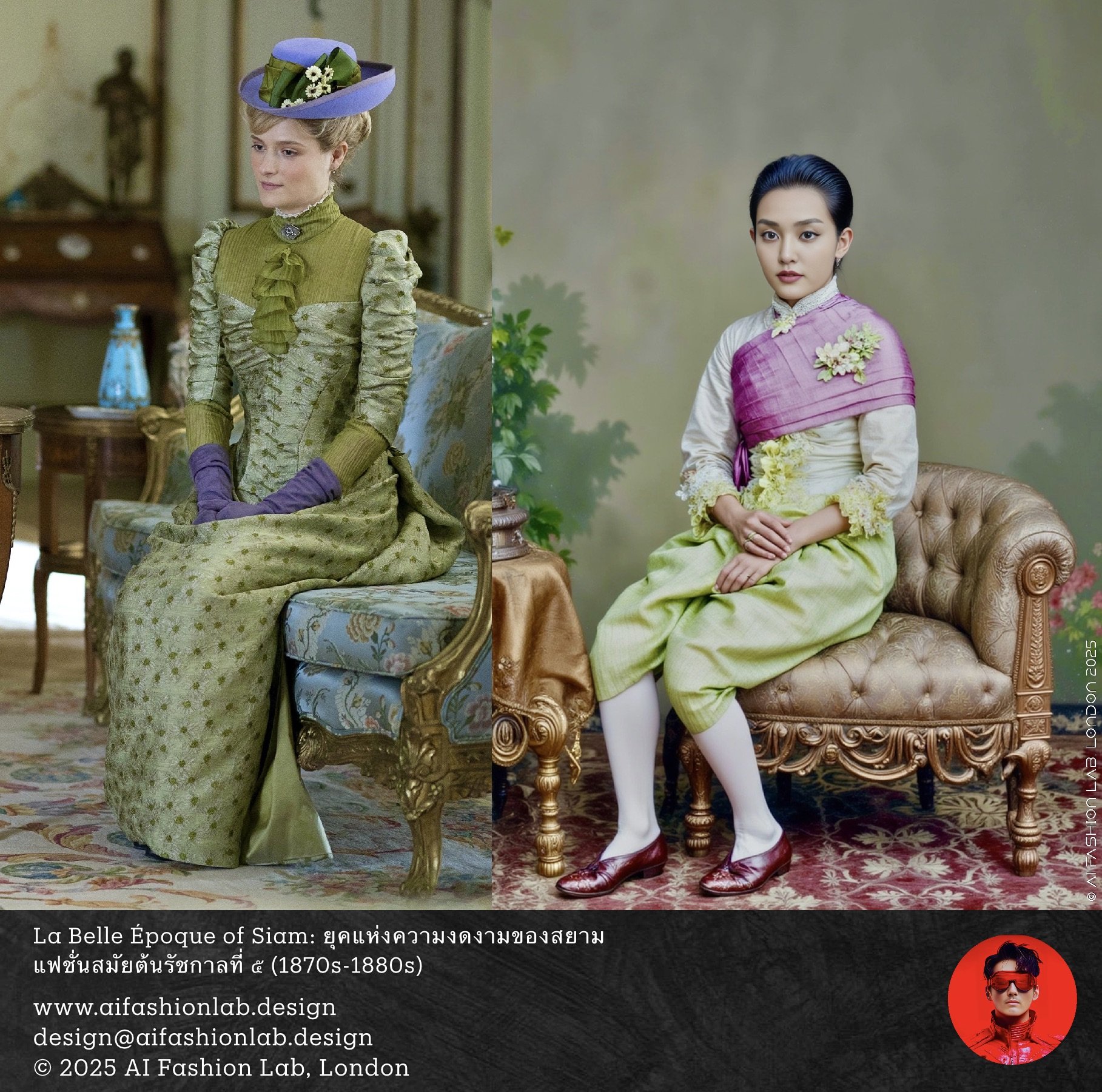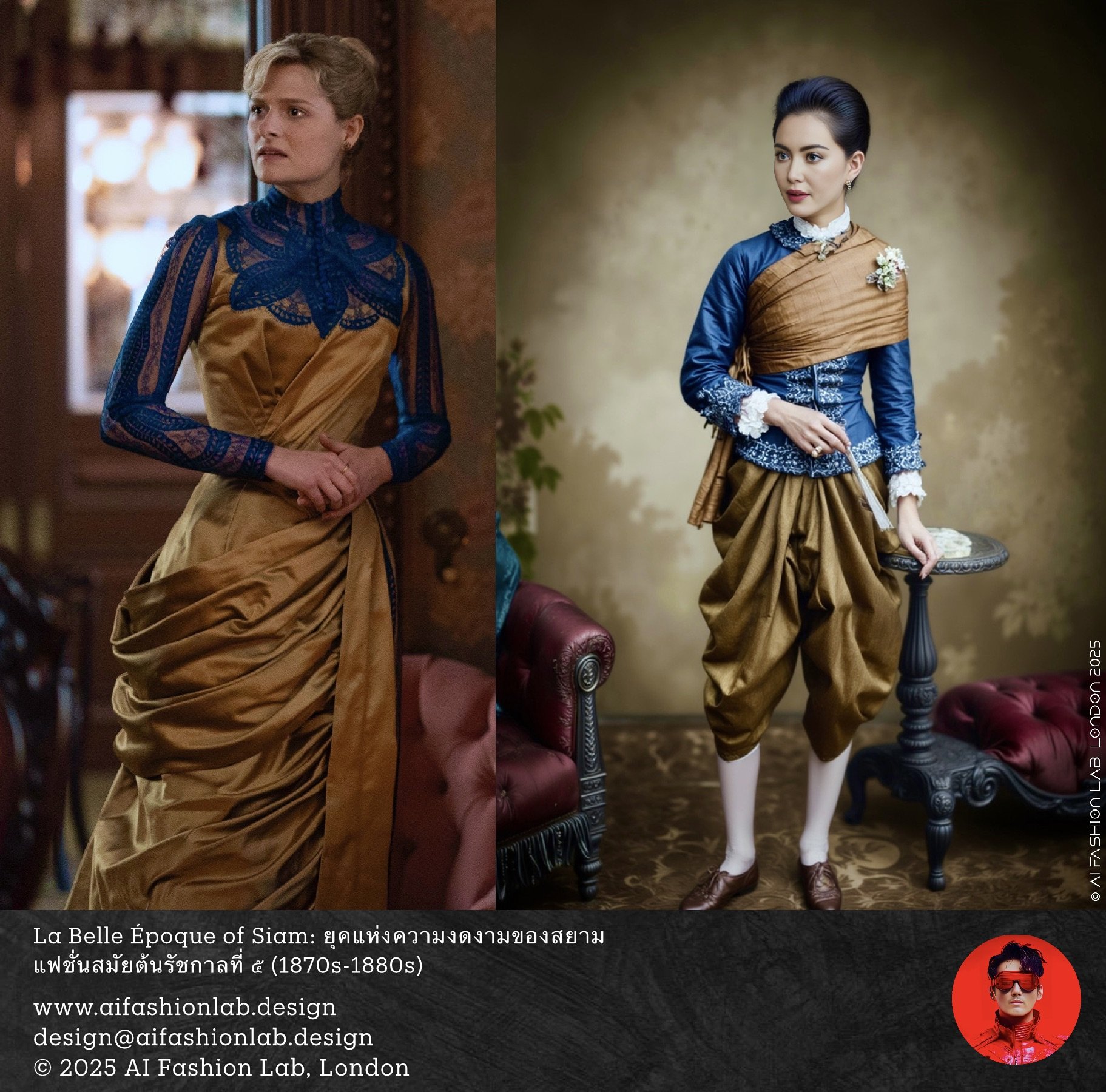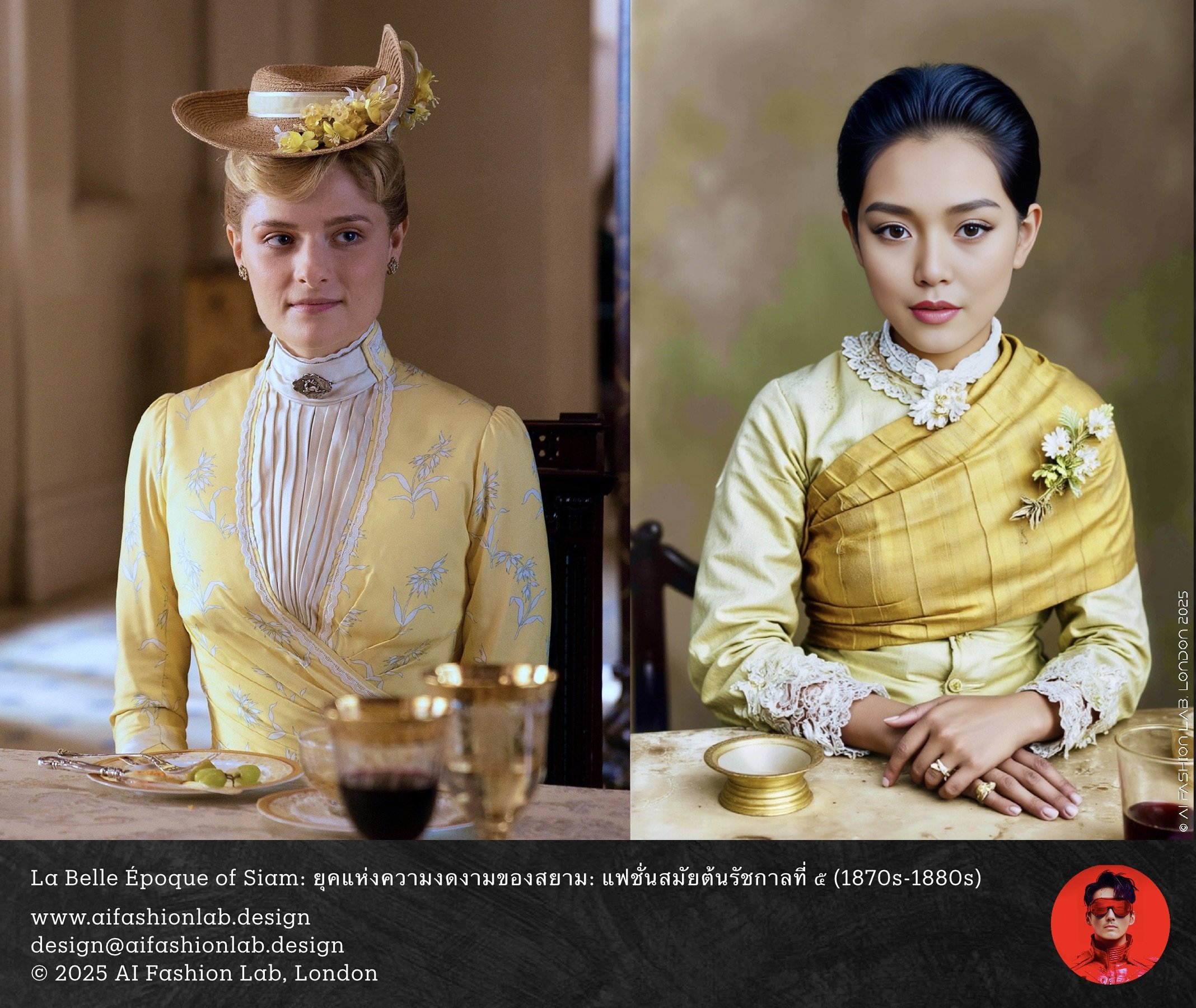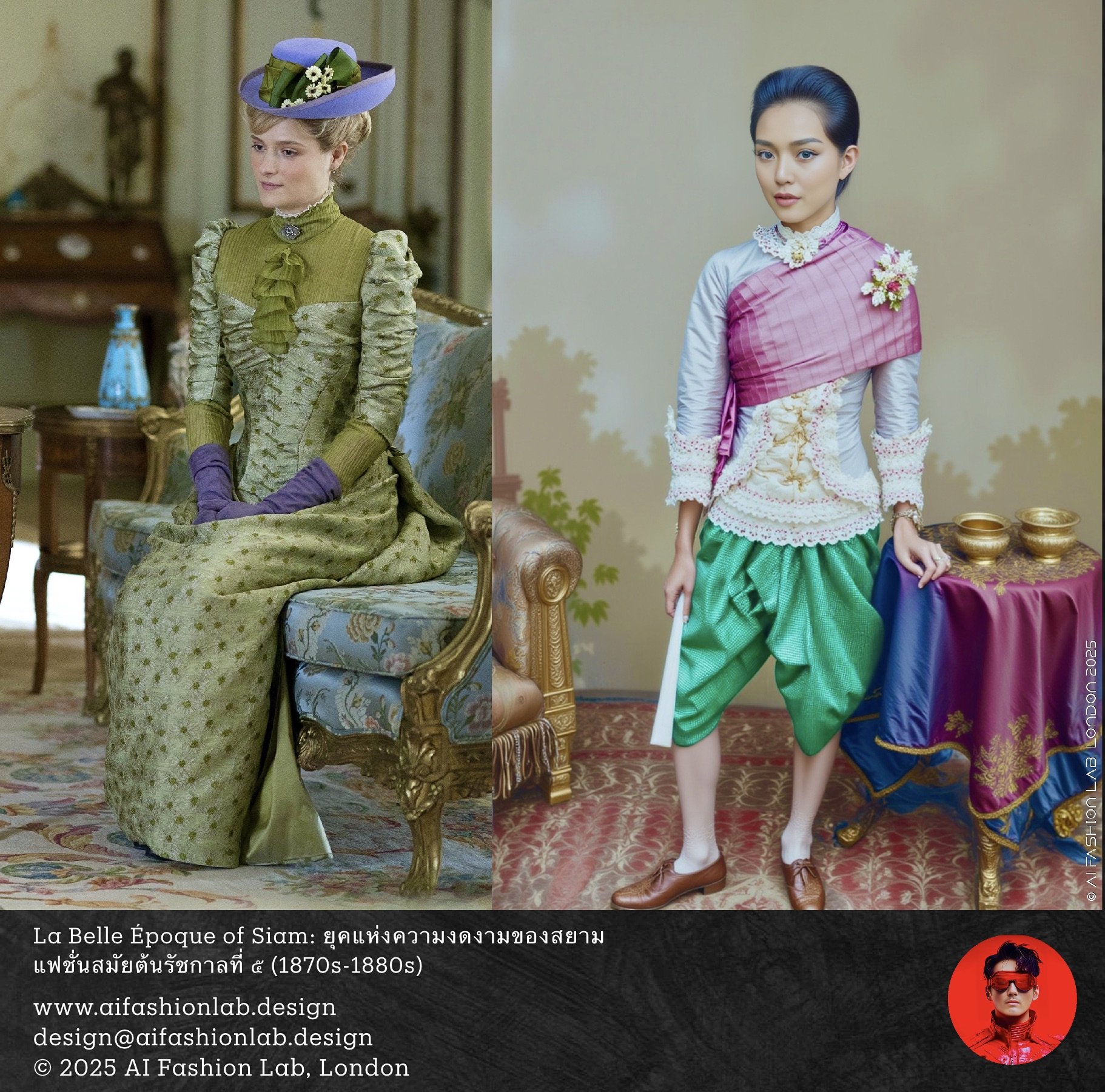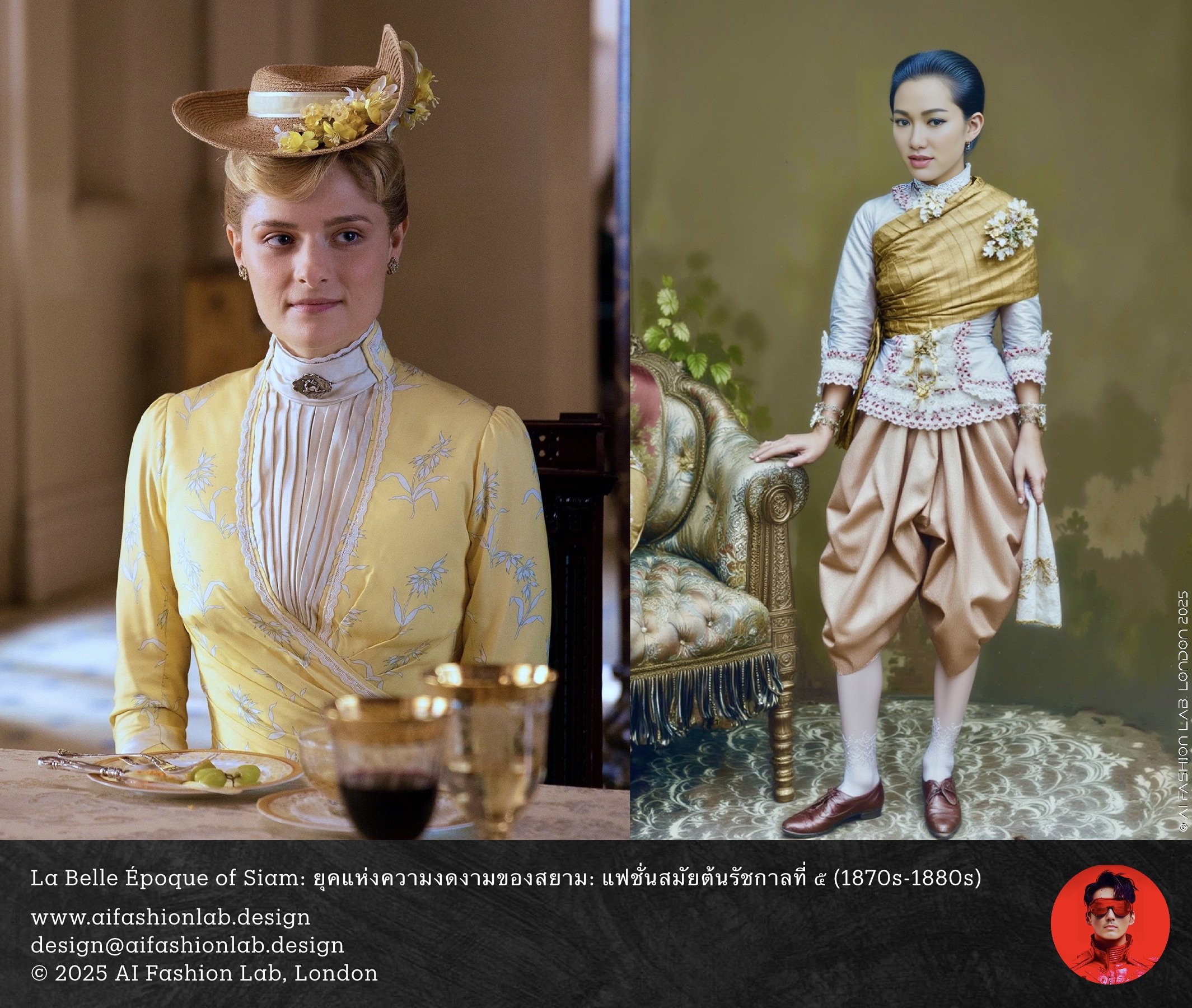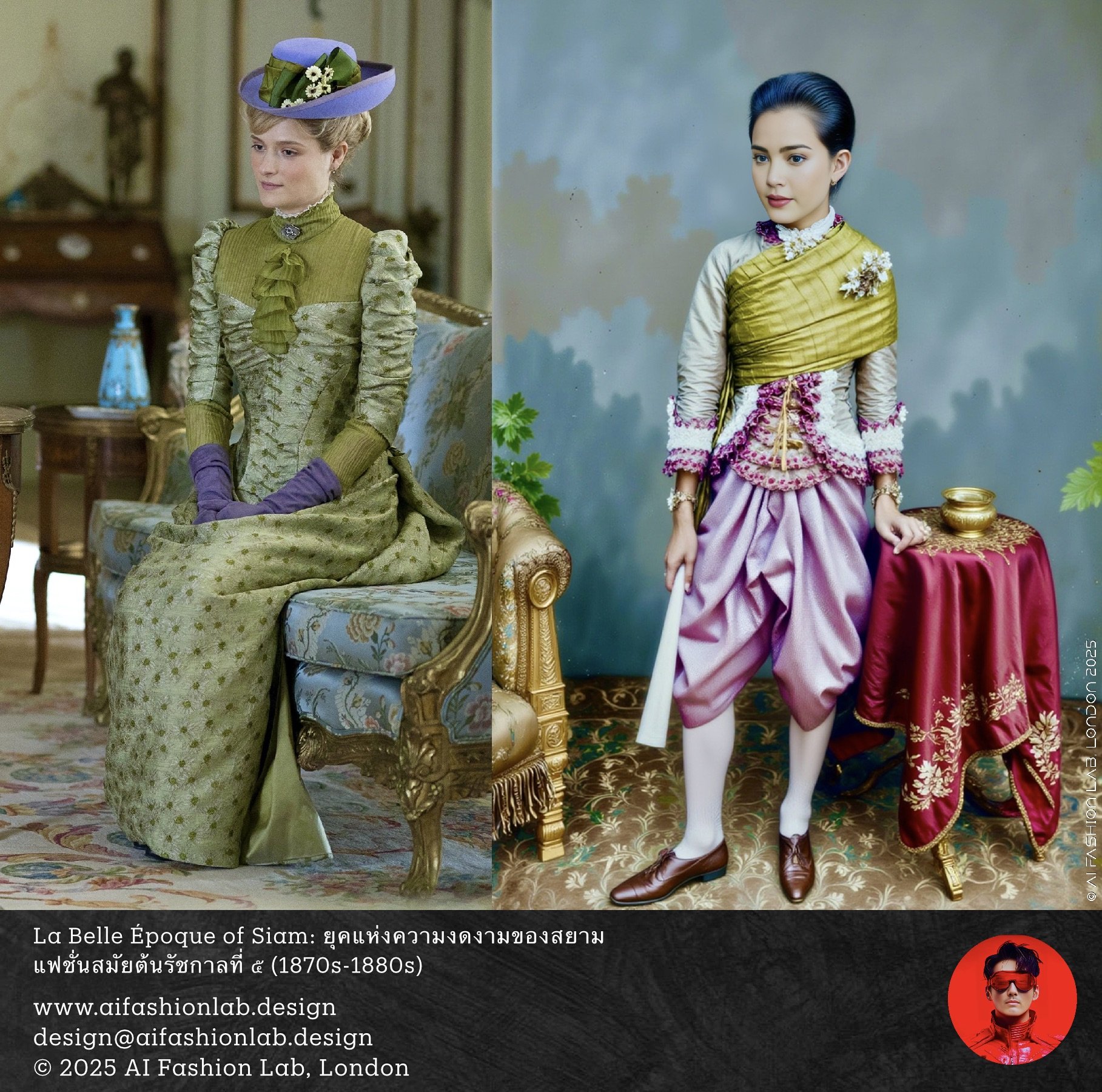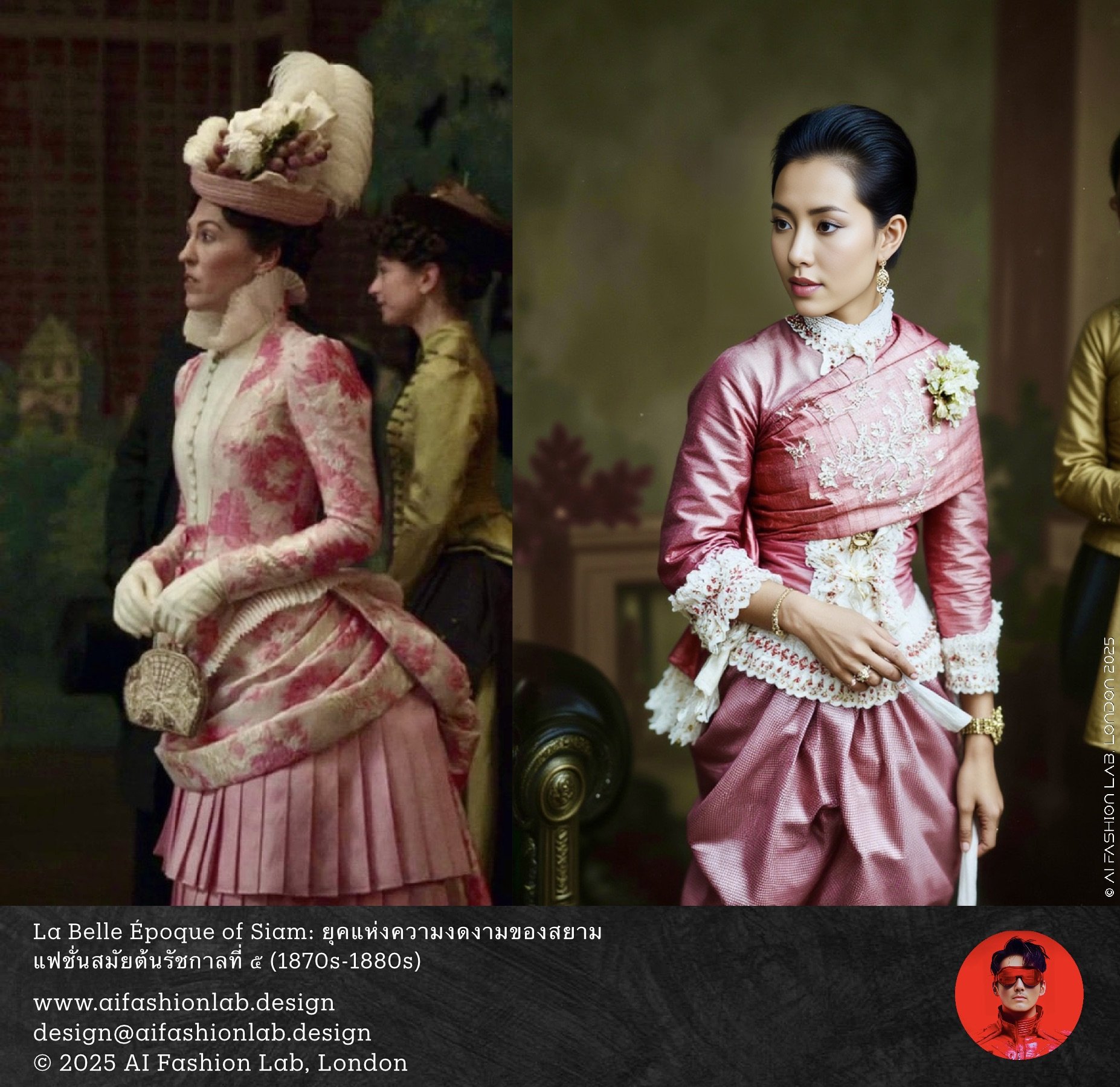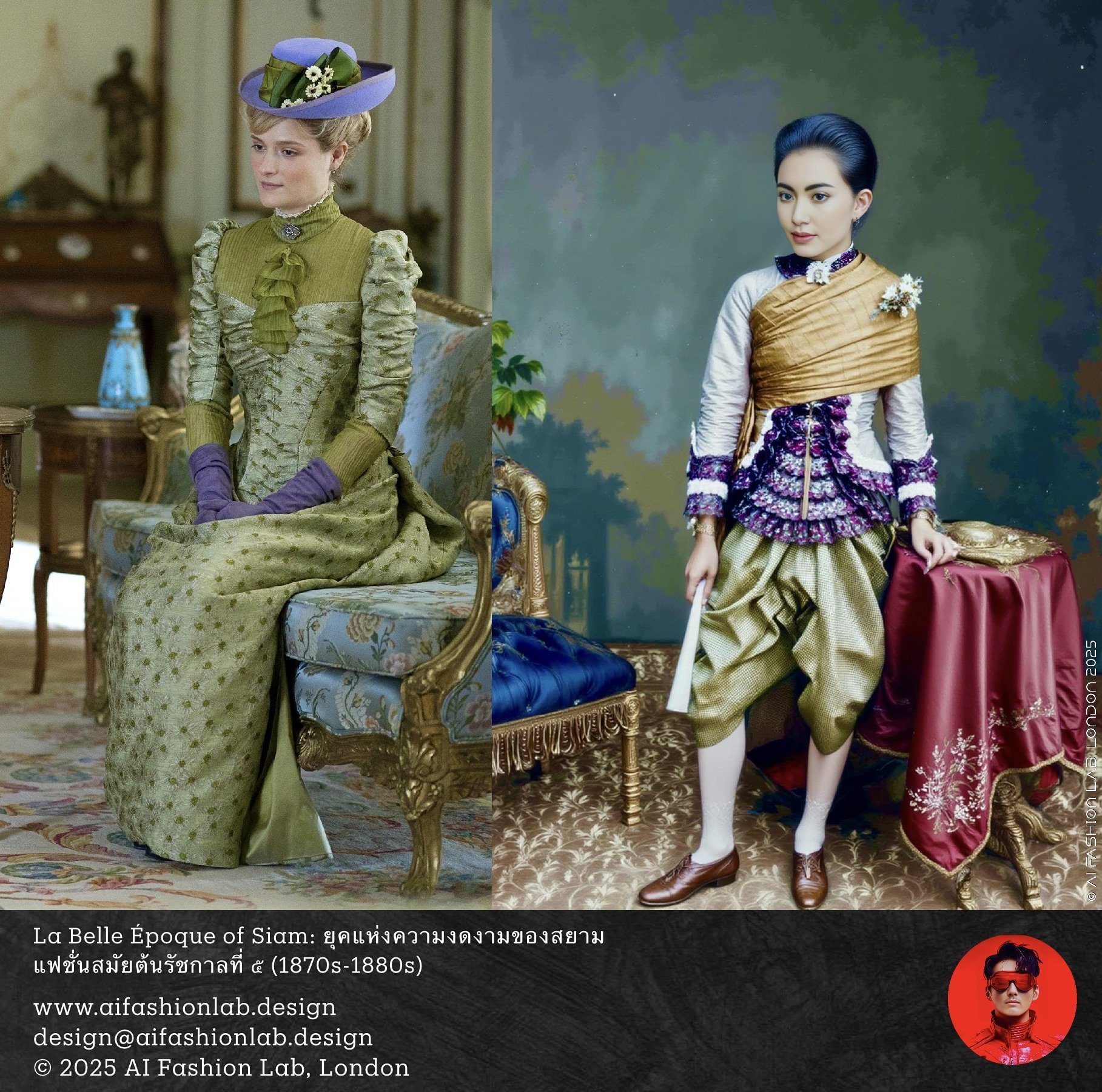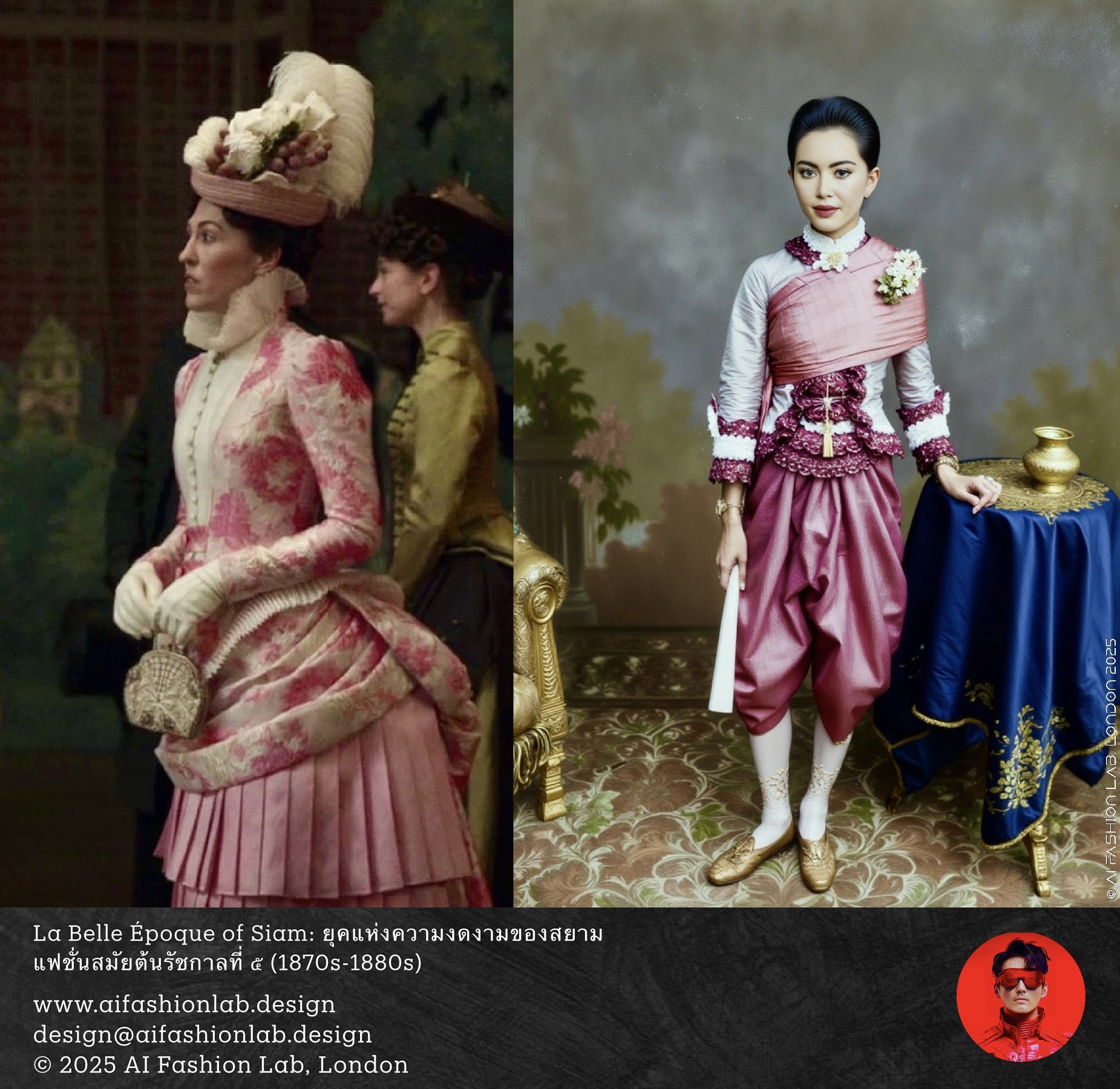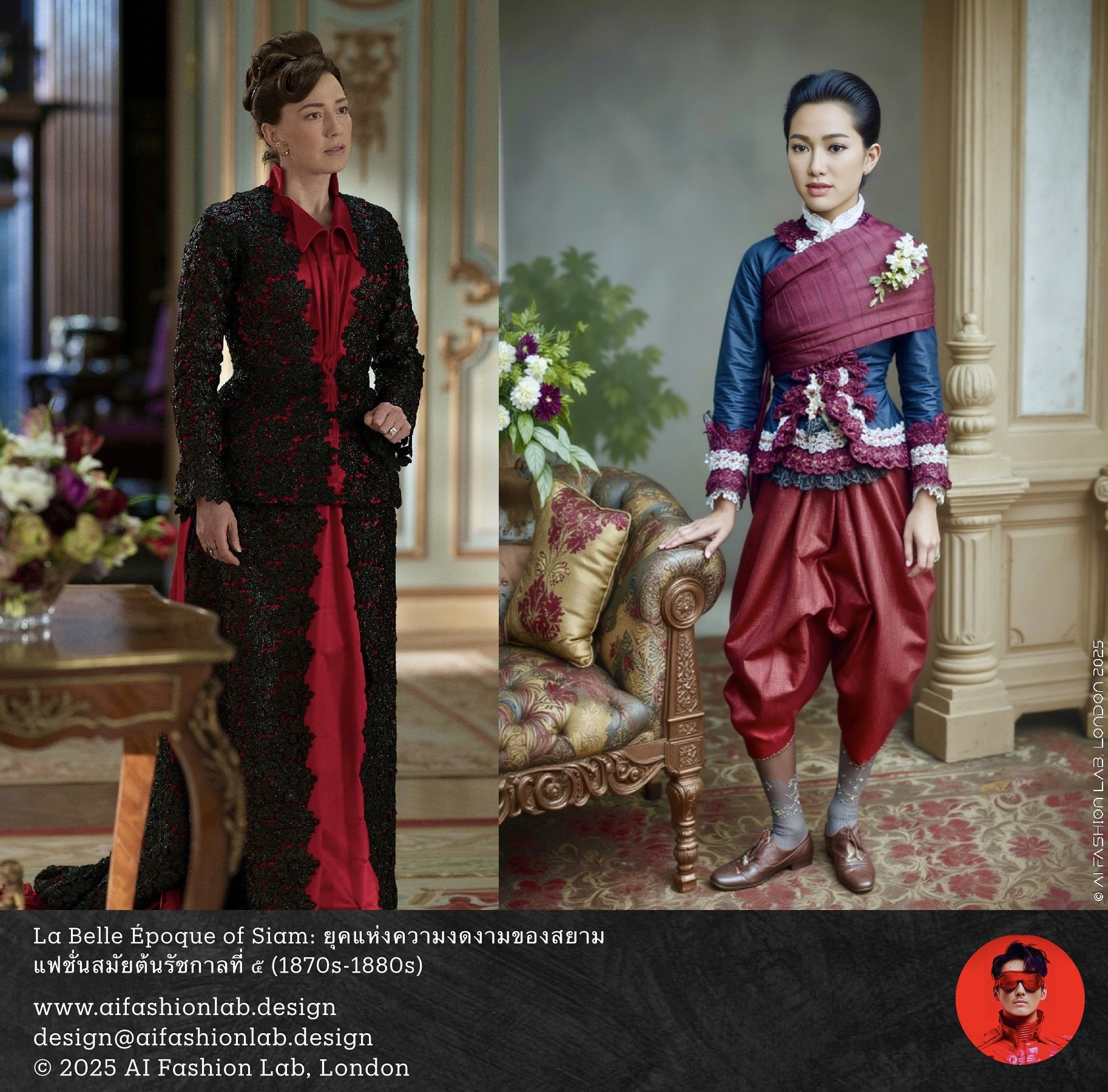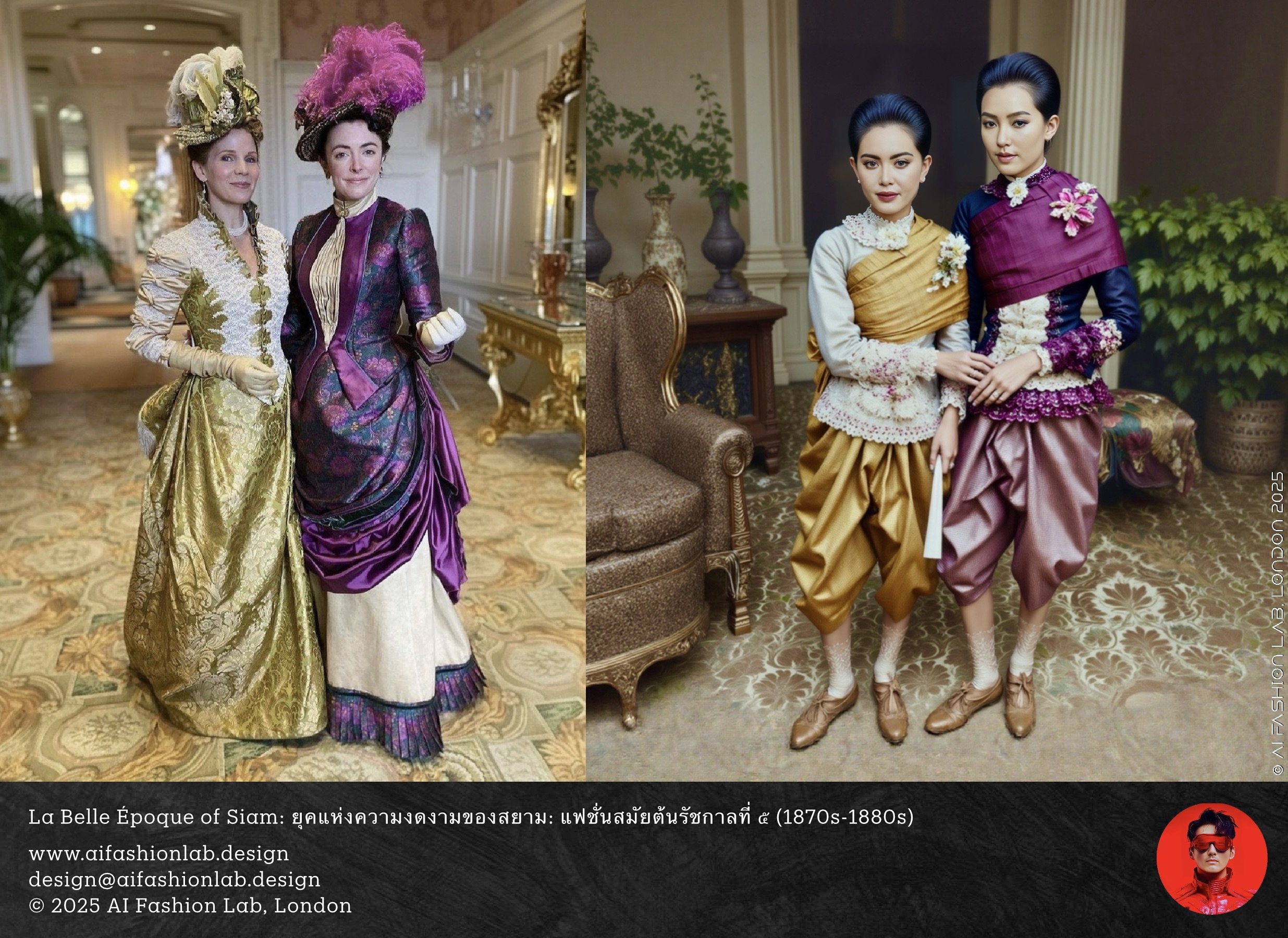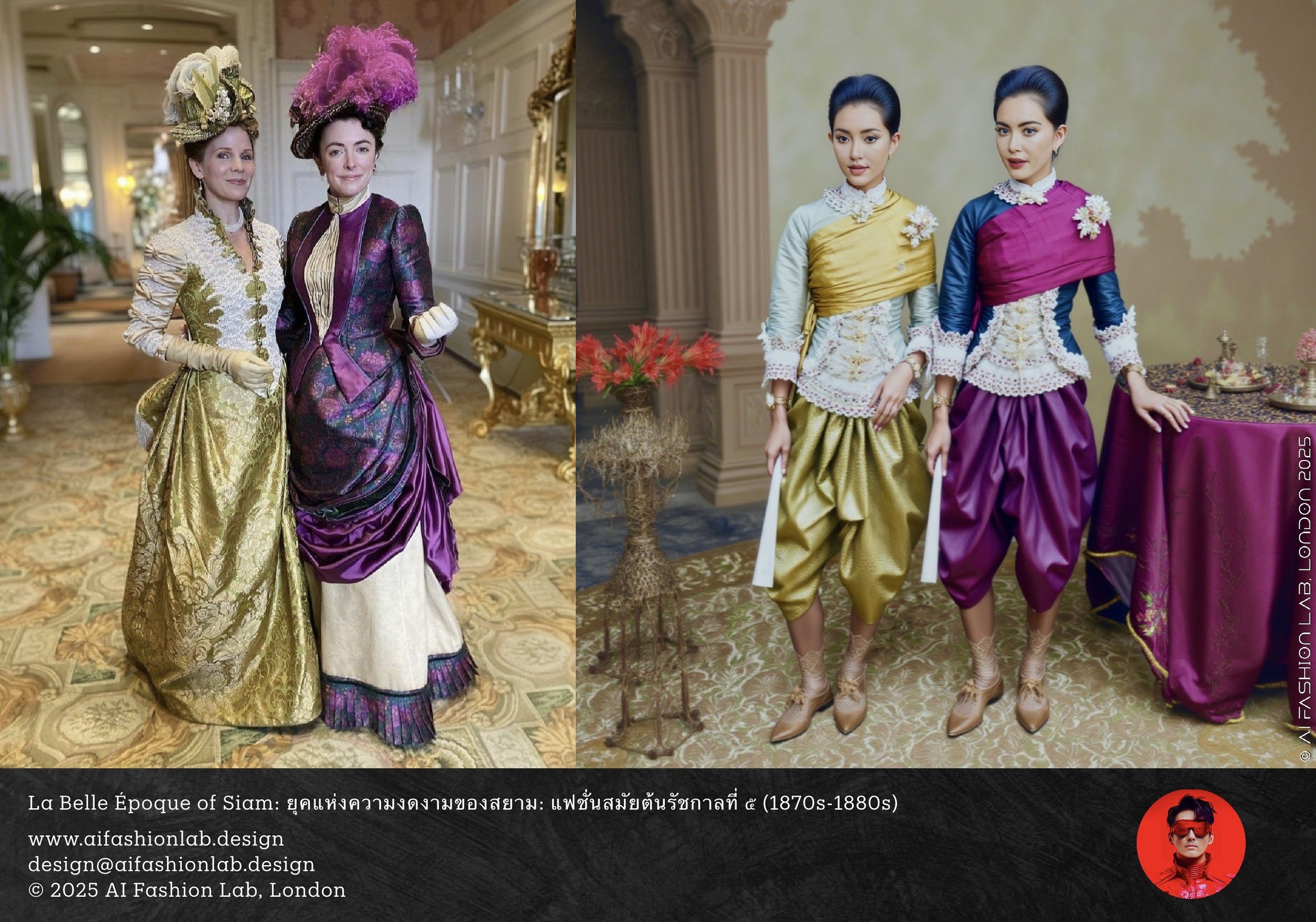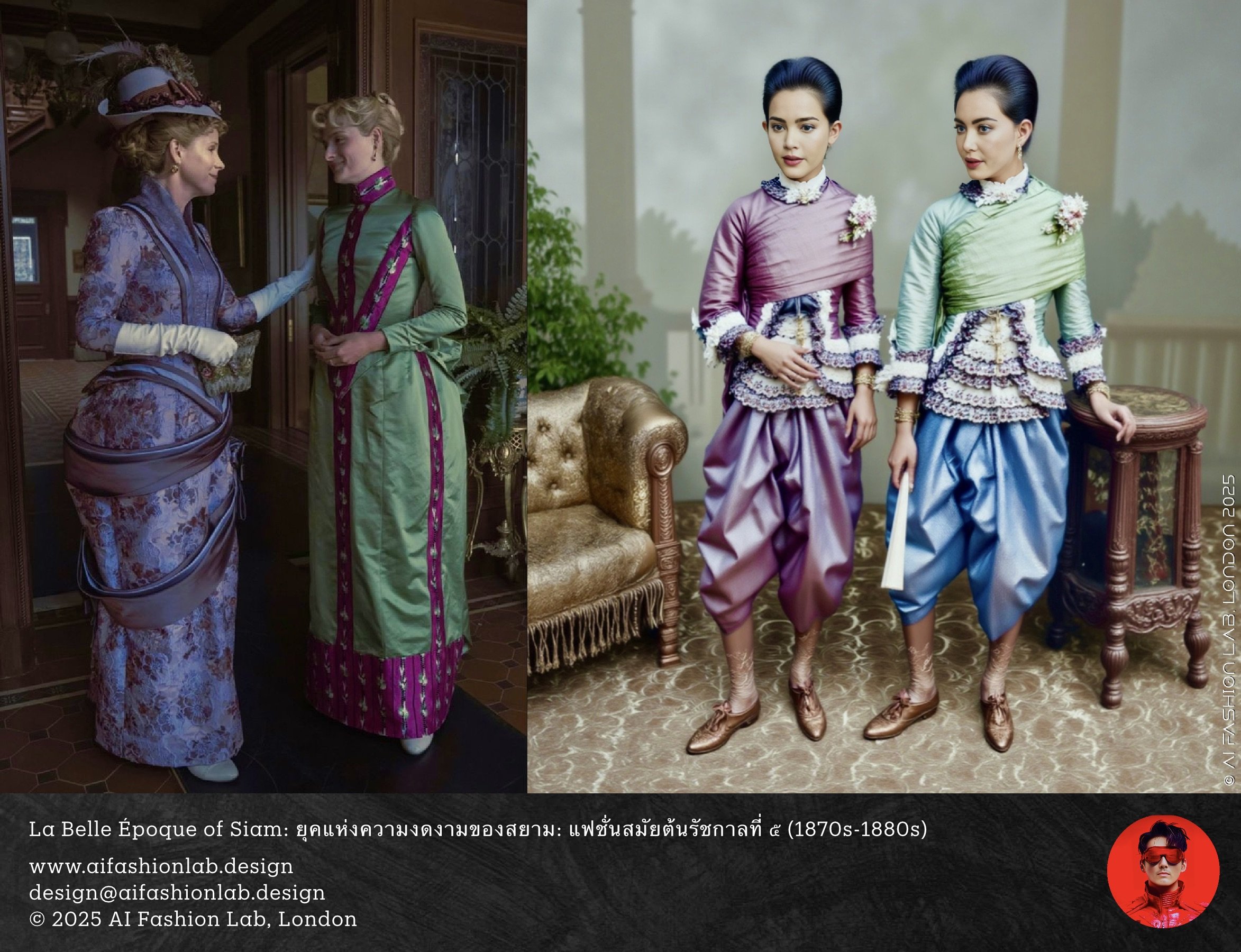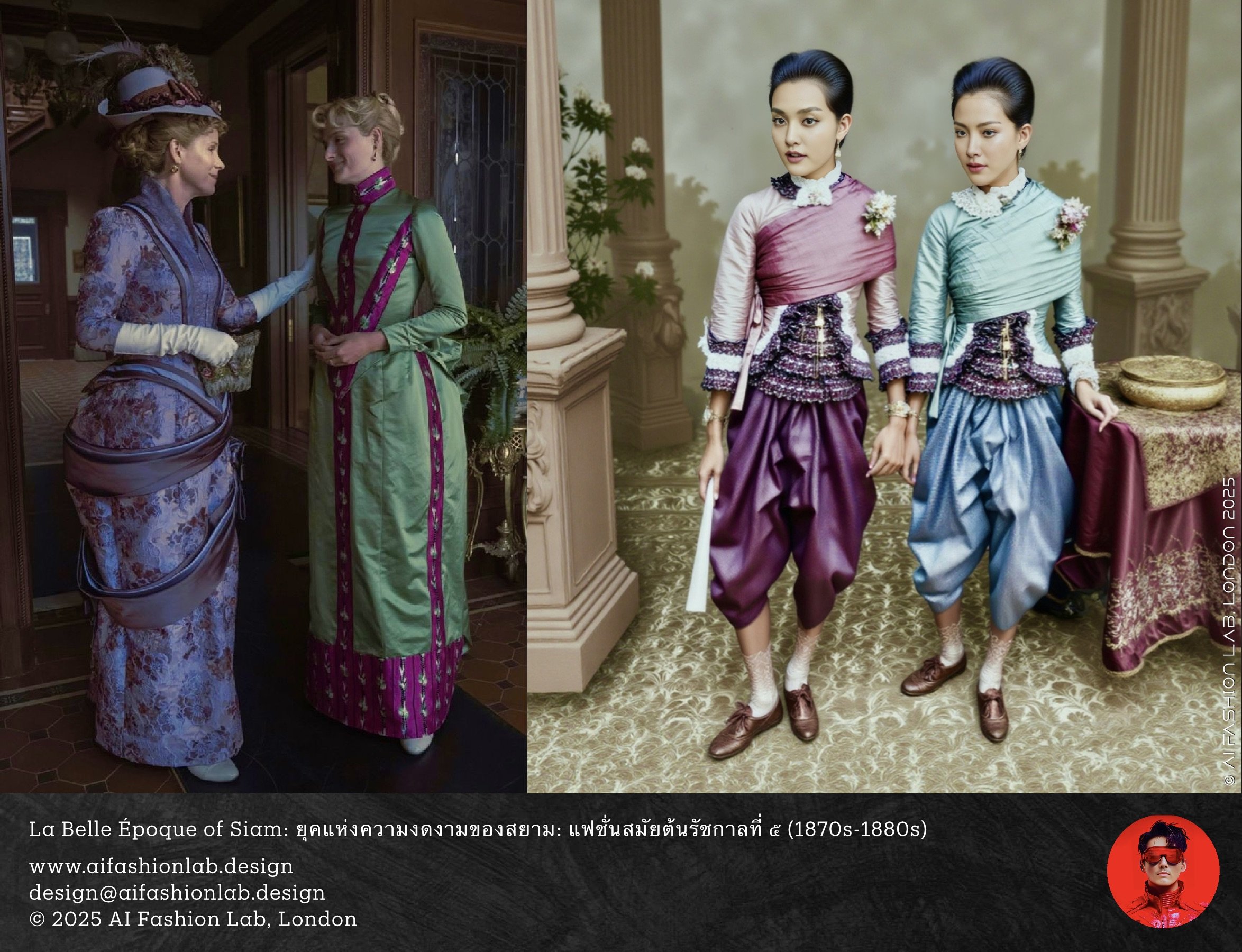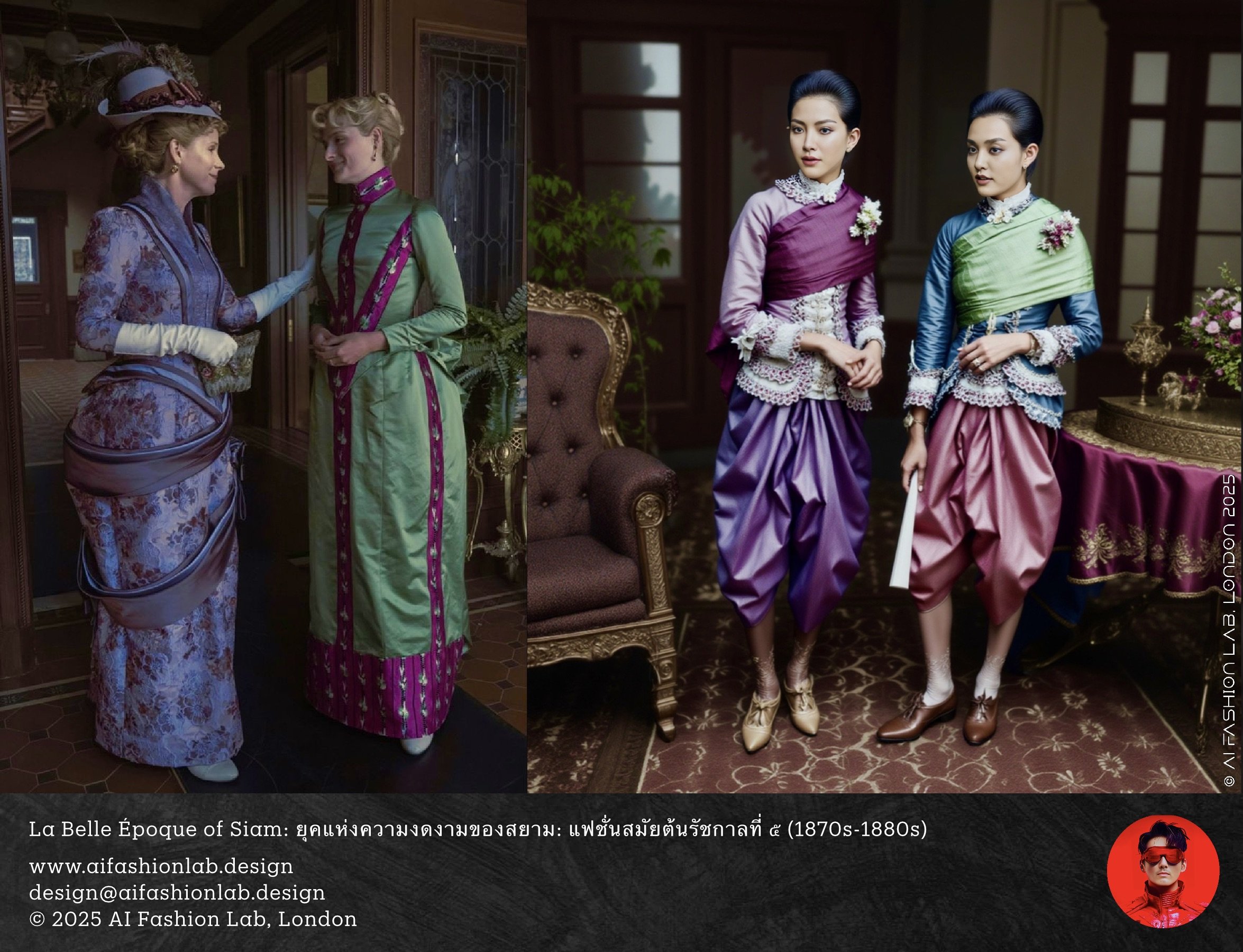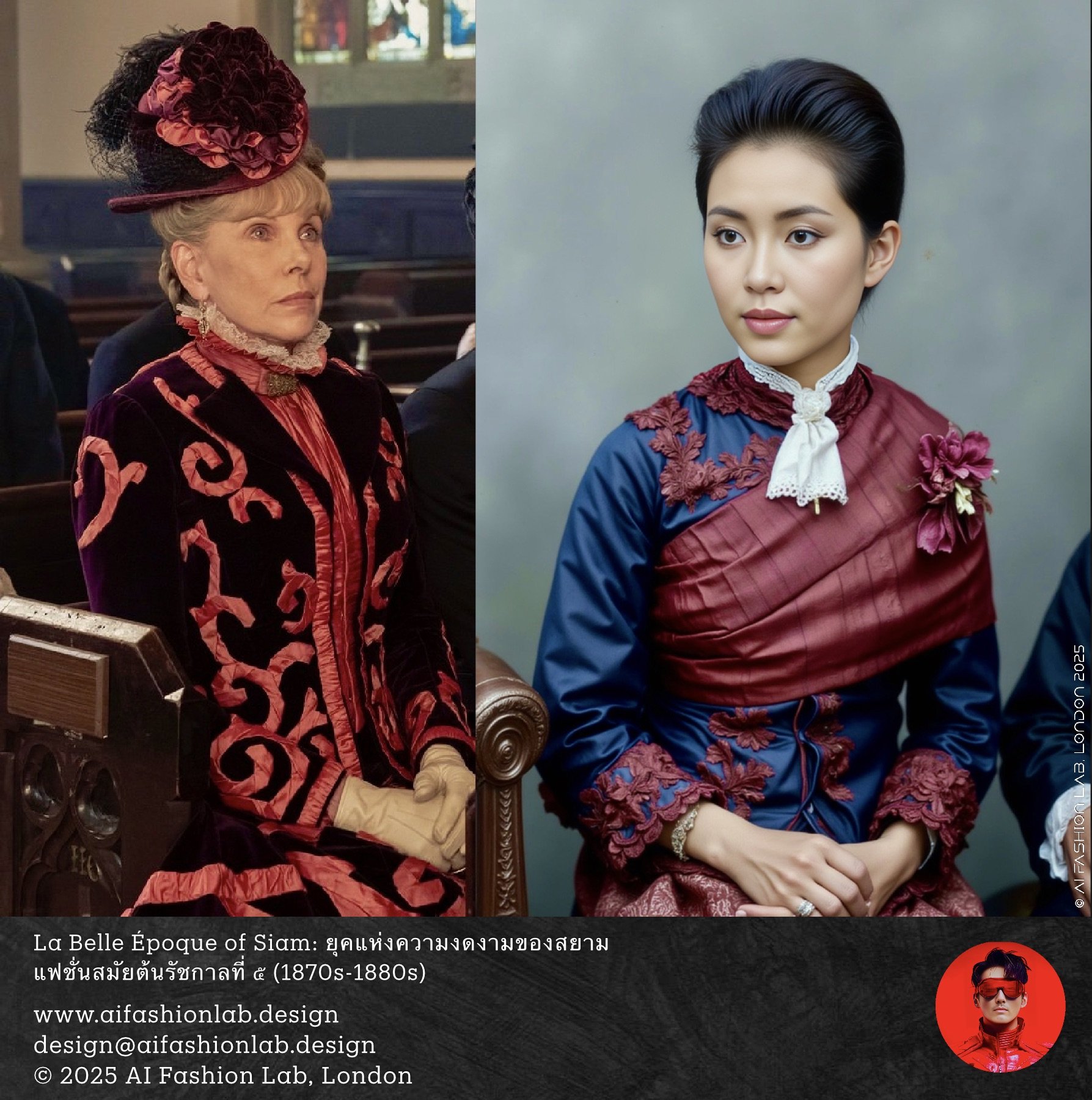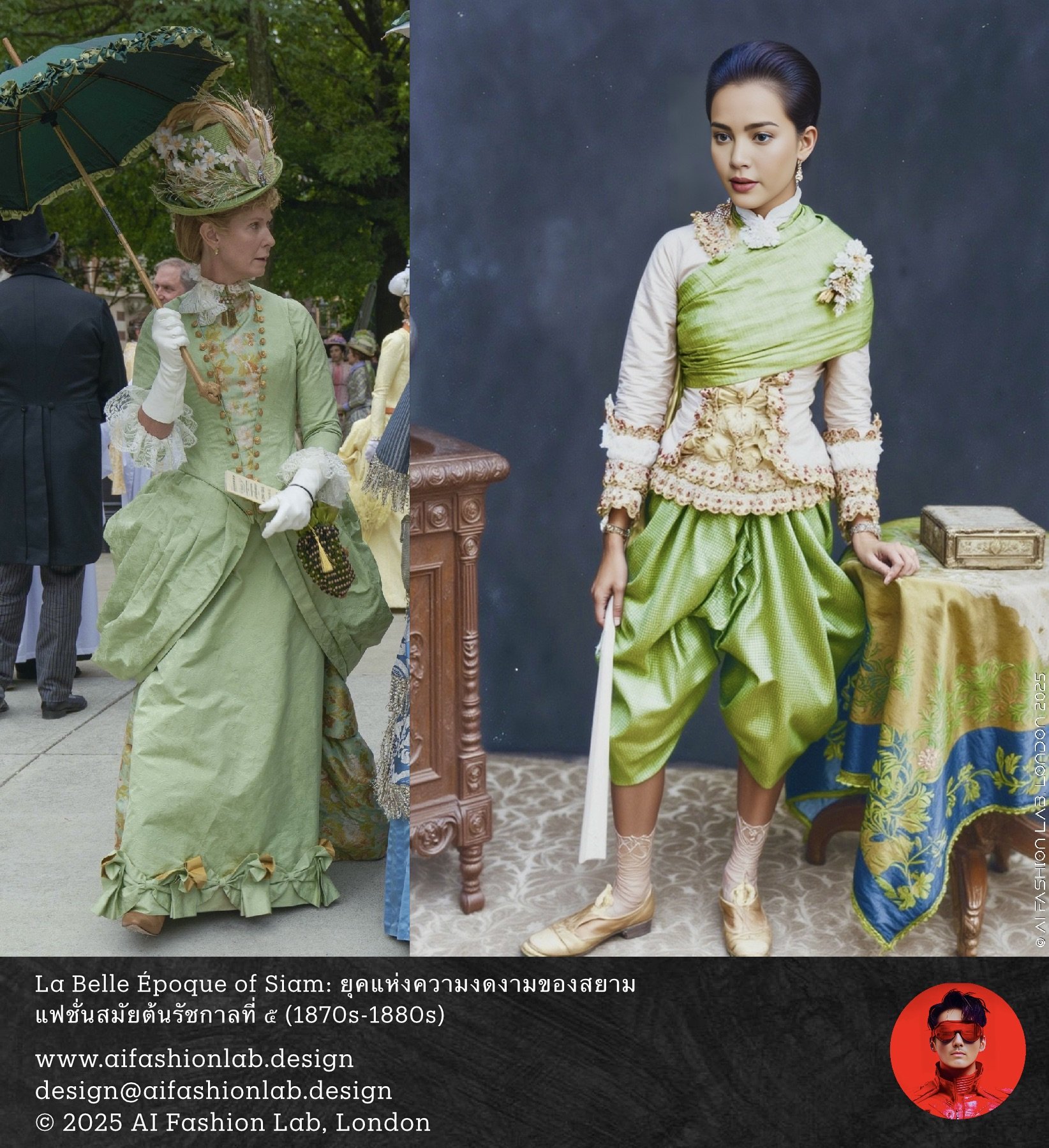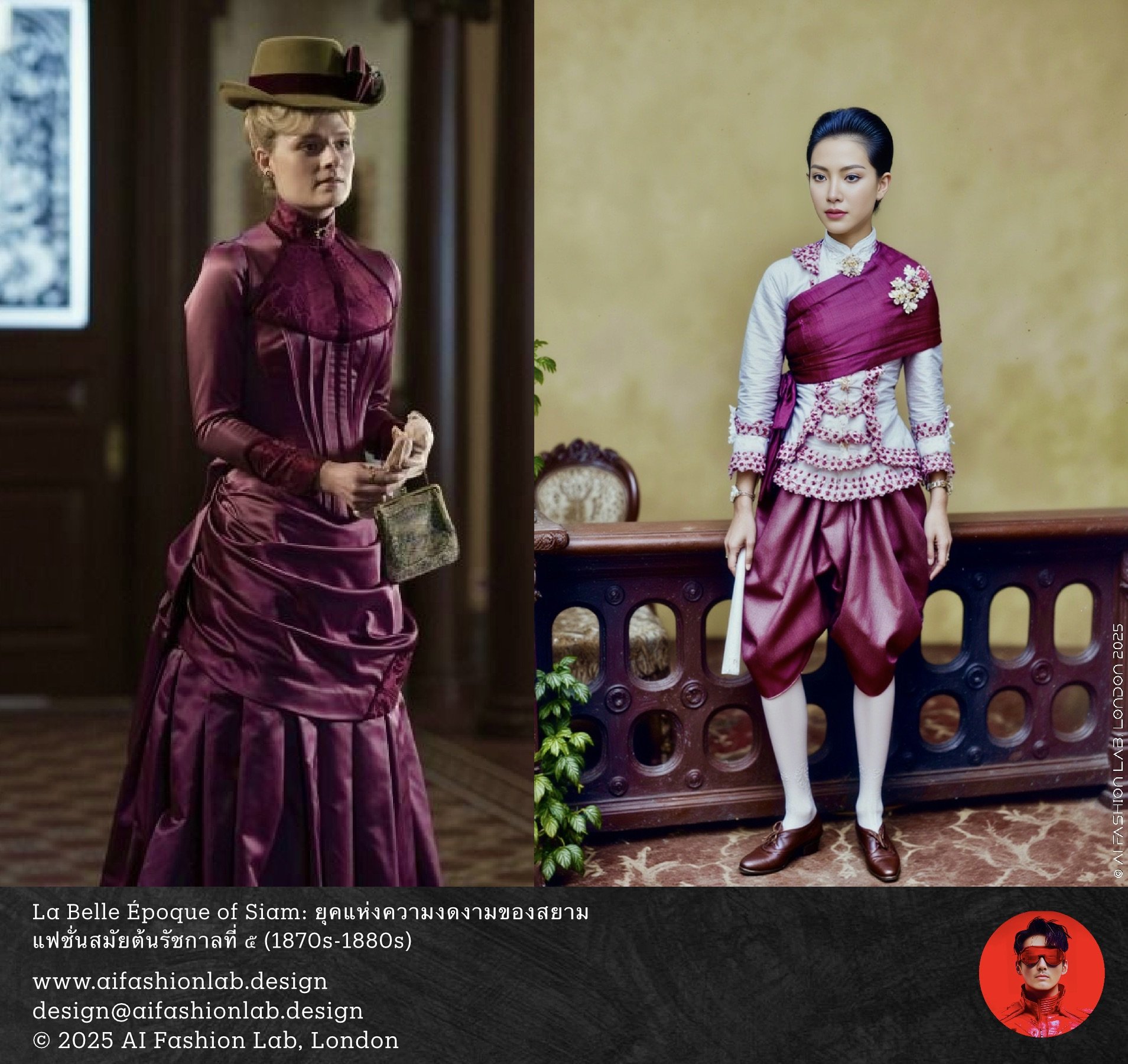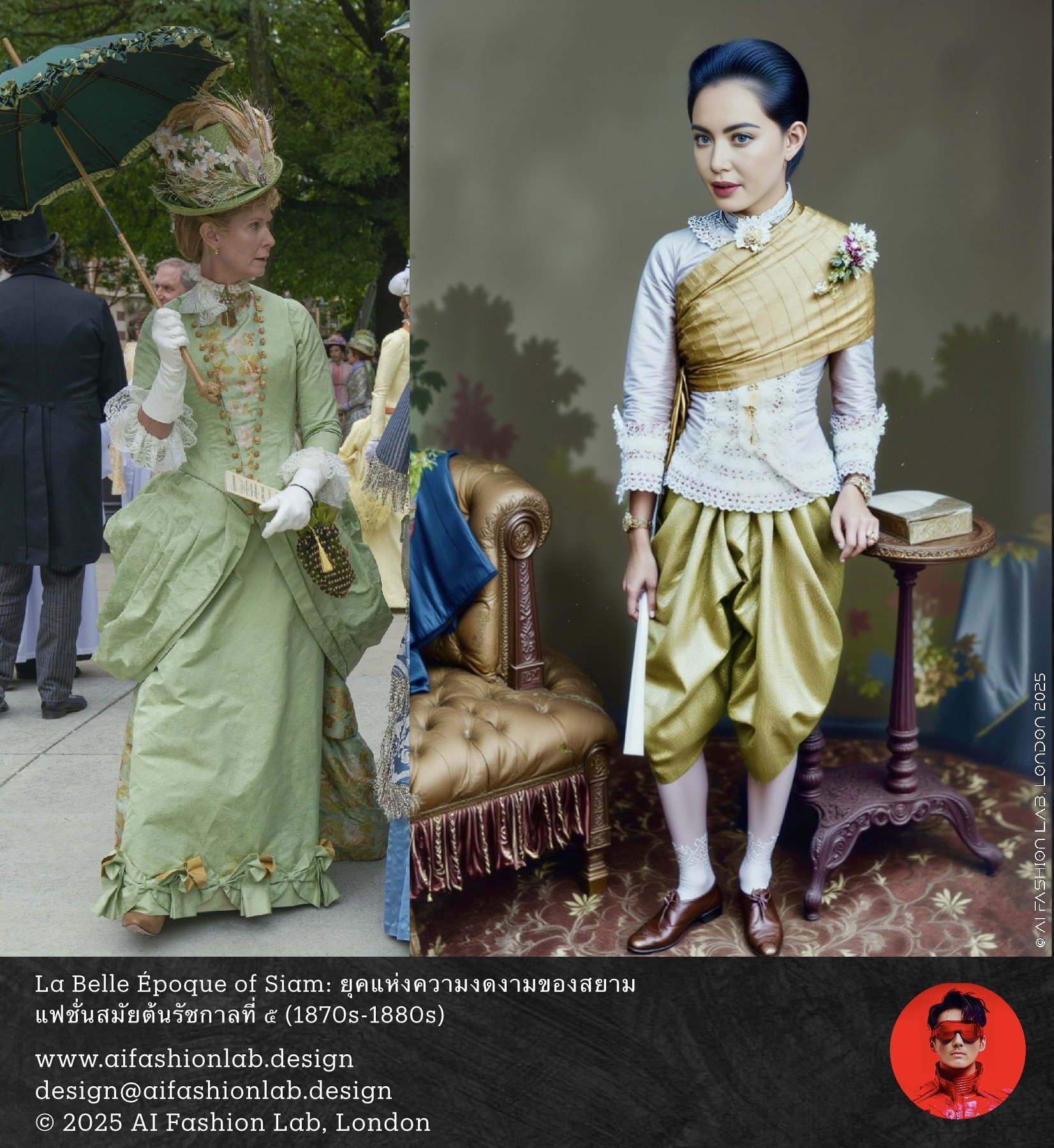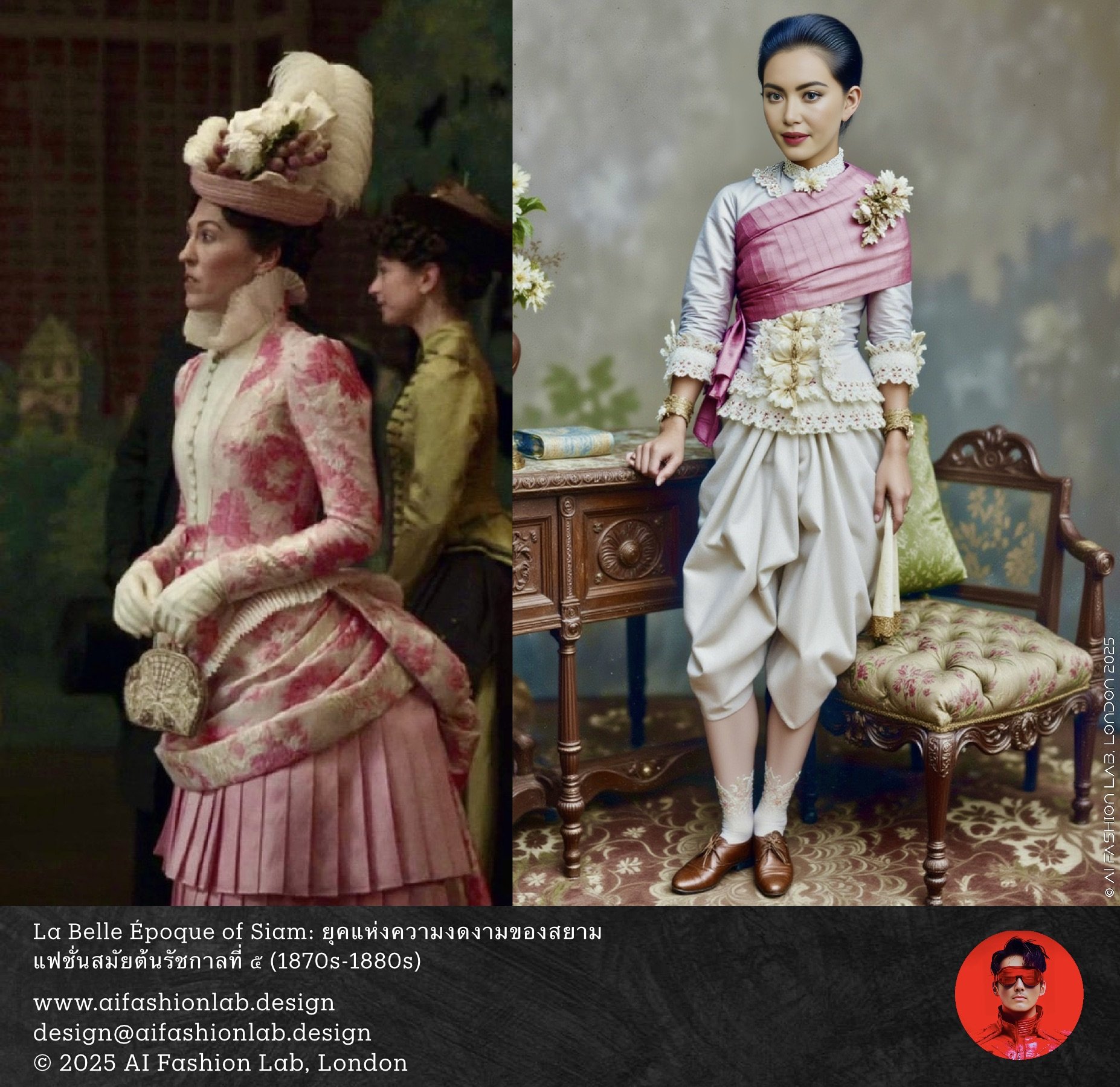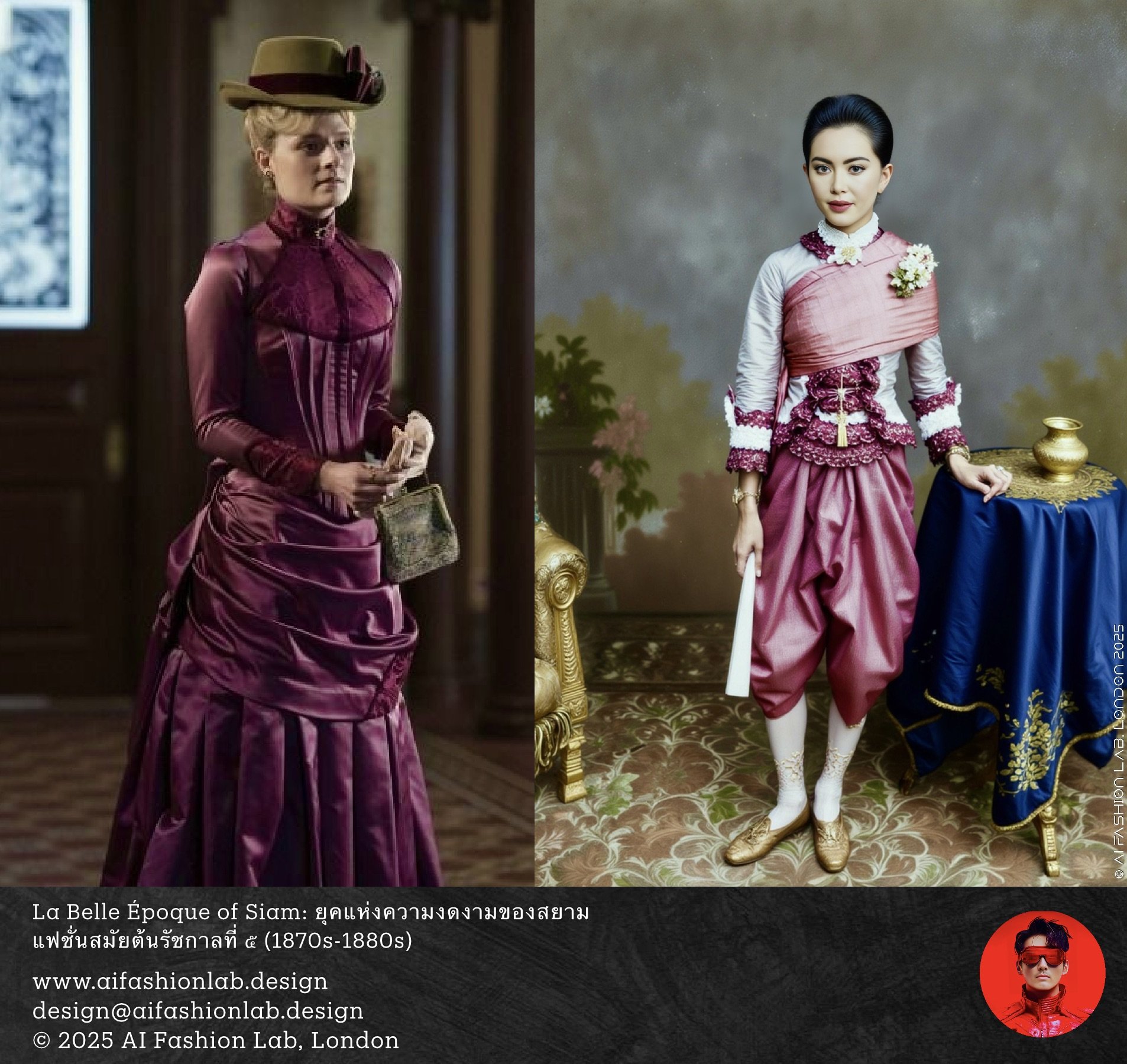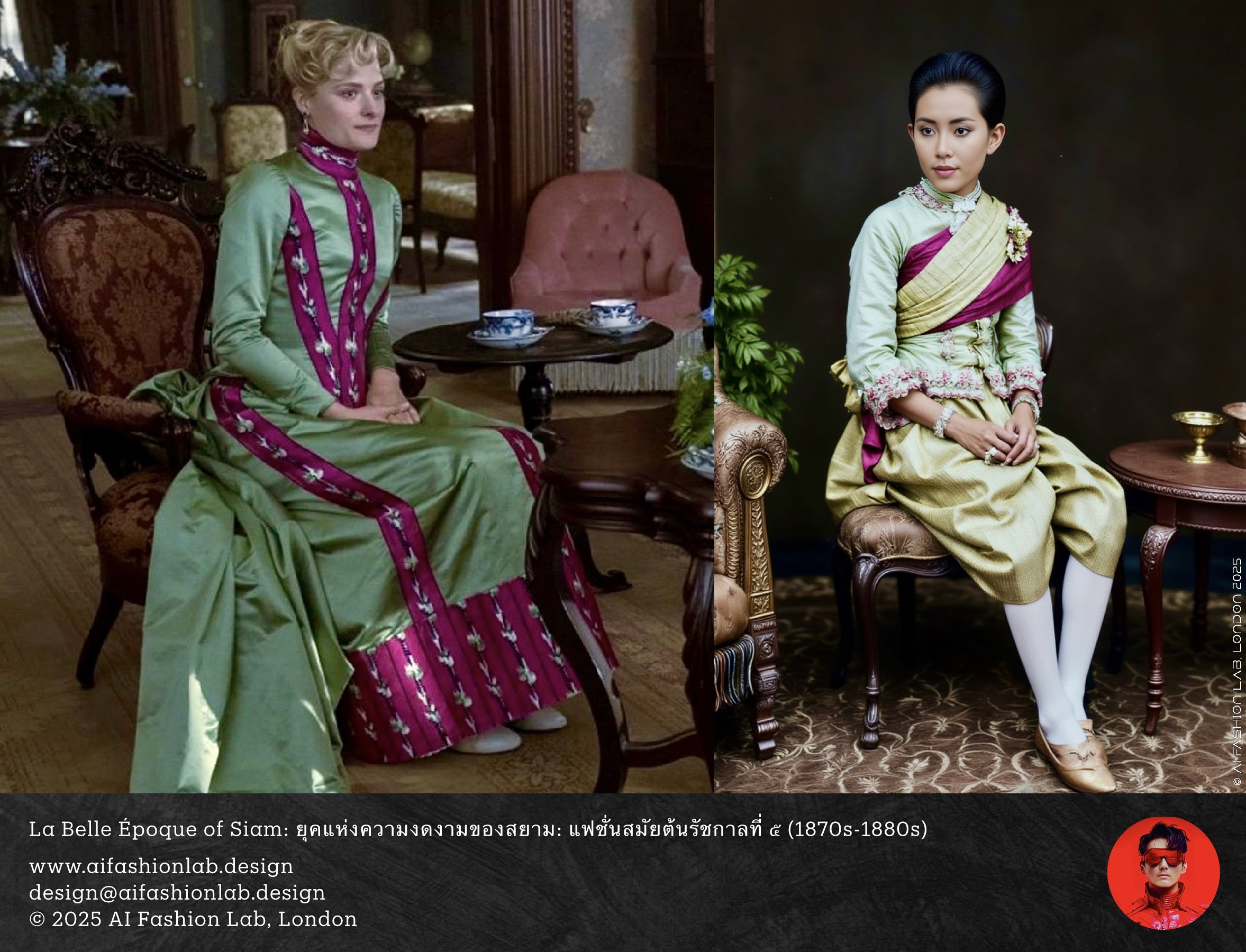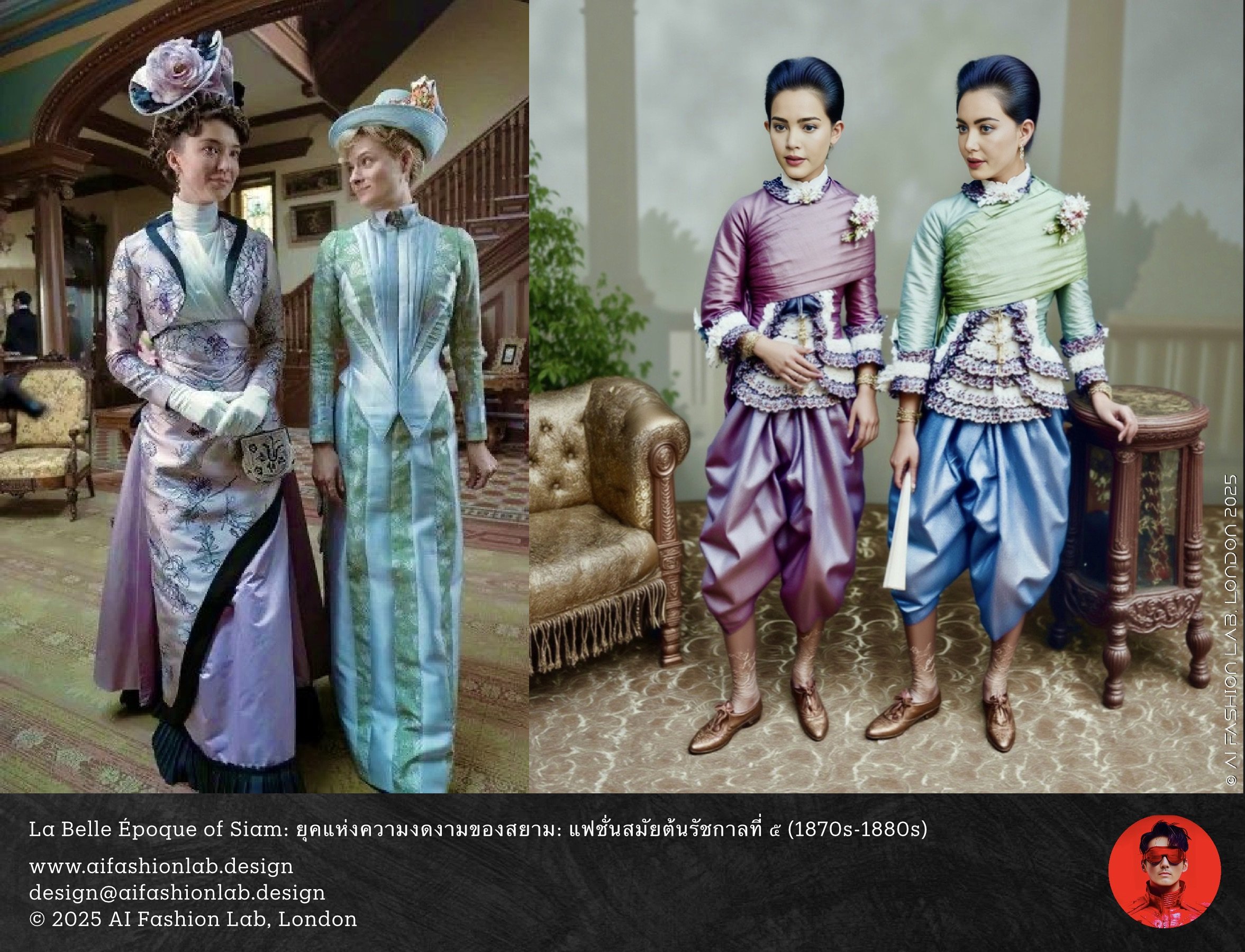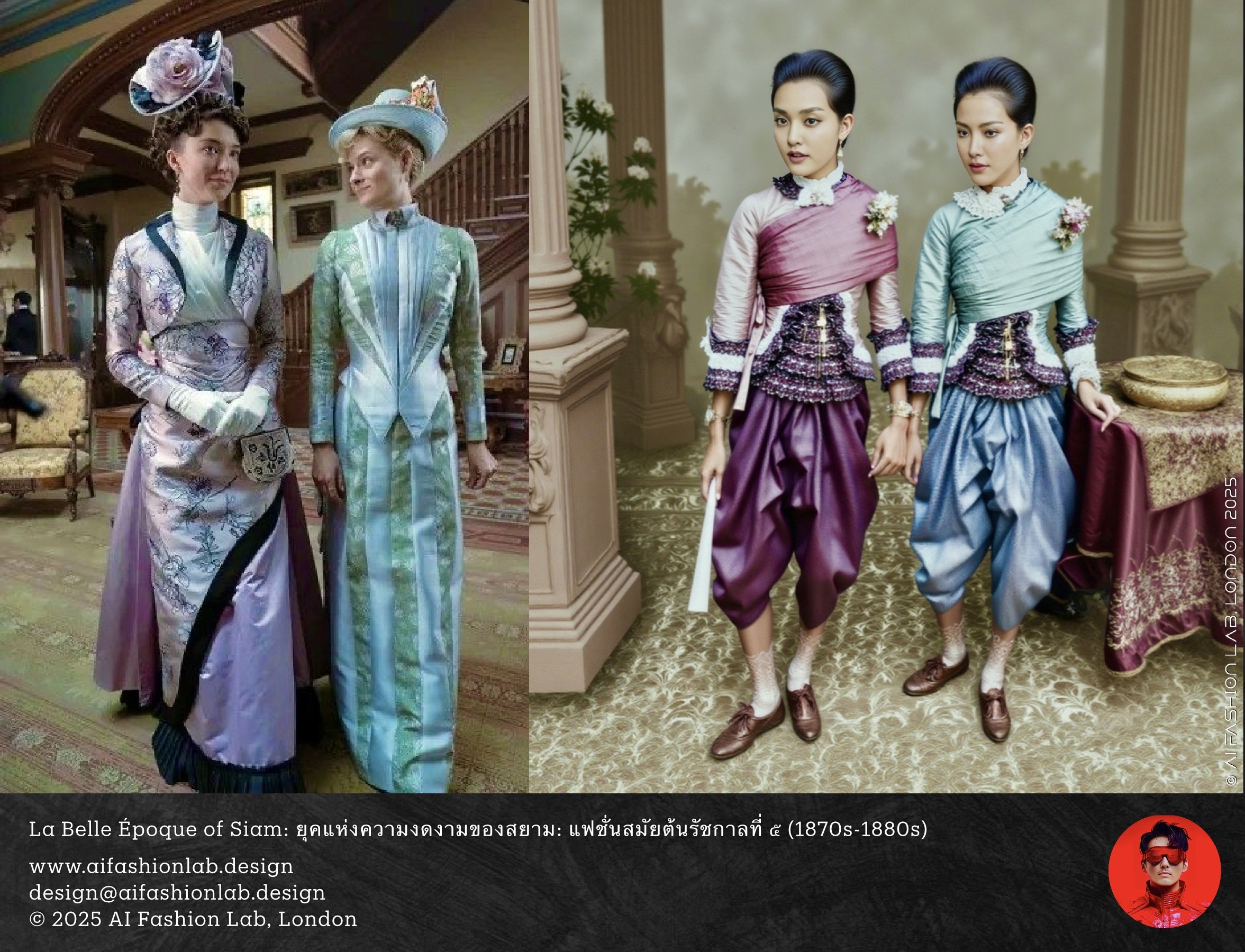La Belle Époque of Siam: The Era of Elegance in the Early Reign of King Rama V (1870s–1880s)
Adapting Western Styles for Siam: Siamese elite women, particularly the ladies of the royal court, embraced Western-inspired blouses with fitted structures, detailed with scalloped lace and made of premium materials like cotton or silk taffeta. In Europe, these blouses were paired with structured skirts and corsets made from whalebone to shape the body according to Western beauty ideals. However, in Siam, the restrictive corsets and rigid understructures were replaced with more flexible tailoring to suit the tropical climate, making these outfits more comfortable to wear.
La Belle Époque of Siam: The Era of Elegance in the Early Reign of King Rama V (1870s–1880s)
To create a clear understanding of fashion during the same period between the Western world and Siam, I have adapted the fashion and silhouettes of Western clothing from the 1870s-1880s (1880 CE) to align with Thai fashion of the same era. This adaptation involved incorporating Western-style blouses into Thai tastes and lifestyles. These blouses were paired with chong kraben and sabai, which are distinct features of traditional Thai attire. This blending achieves a balance between Western elegance and Thai simplicity, highlighting the differences between adopting Western fashion and tailoring it to suit Siamese culture.
The late 19th century was a period of rapid cultural and social change across the globe. In Europe, the era was known as La Belle Époque, a time of artistic flourishing, technological advancement, and optimism in countries like France and Britain. Meanwhile, in the United States, this period was marked as The Gilded Age, characterised by industrial growth, wealth disparity, and significant societal transformation. Siam, under the reign of King Chulalongkorn (Rama V), experienced its own version of La Belle Époque. This was a time of modernisation and reform, as the king sought to strengthen Siam's position on the global stage by adopting Western technology, education, and cultural practices while maintaining the country’s independence amidst colonial pressures.
Fashion became a prominent symbol of these changes. In the West, this era saw the rise of elaborate and structured clothing, such as the bustle skirts and corseted waists that defined feminine silhouettes. Siamese elites, particularly the nobles and ladies of the inner court, adopted elements of this Western fashion, integrating them into traditional Thai dress. This fusion of styles represents a unique intersection of global influences and local identity, reflecting Siam’s effort to modernise while preserving its cultural heritage.
This article explores how Siamese fashion during this period mirrored the opulence and refinement of Western styles while maintaining its own distinctive characteristics. Through this analysis, readers can gain insight into the cultural fusion that defined La Belle Époque in Siam and how it compared to its Western counterparts.
The Global Context: La Belle Époque and Its Impact on Siam: In the late 19th century, the Western world was in the midst of La Belle Époque ("The Beautiful Era"), a time marked by flourishing art, culture, and technological innovation, especially in countries like France and Britain. This era reflected grandeur and prosperity, with fashion serving as a symbol of wealth and social status. In the United States, this same period was known as The Gilded Age, characterised by rapid industrial growth, significant economic inequality, and social transformation.
For Siam, this era coincided with King Rama V's reign, a period of modernisation and reform. Known as La Belle Époque of Siam, this era saw the country embracing Western advancements in technology, education, and culture to strengthen its independence amid the pressures of colonial expansion. Fashion during this time became an essential symbol of these changes.
Western Fashion in La Belle Époque and Its Siamese Adaptation: In Europe, women’s fashion during La Belle Époque was defined by complex designs, such as the bustle skirt with exaggerated back structures to create a dramatic silhouette. These outfits were adorned with lace, luxurious fabrics, and intricate embroidery, representing the wealth and sophistication of the wearer. In Siam, elements of these Western fashions were adopted by the royal court and upper class but were creatively adjusted to align with Thai traditions and climate.
Adapting Western Styles for Siam: Siamese elite women, particularly the ladies of the royal court, embraced Western-inspired blouses with fitted structures, detailed with scalloped lace and made of premium materials like cotton or silk taffeta. In Europe, these blouses were paired with structured skirts and corsets made from whalebone to shape the body according to Western beauty ideals. However, in Siam, the restrictive corsets and rigid understructures were replaced with more flexible tailoring to suit the tropical climate, making these outfits more comfortable to wear.
These Western-style blouses were often paired with traditional chong kraben and sabai, creating a harmonious blend of Western tailoring and Thai cultural identity. This combination allowed the Siamese women to maintain their traditional elegance while reflecting the modernity of the era.
Hairstyles and Accessories in La Belle Époque of Siam: Hairstyles among Siamese elite women during this time were simple yet distinct. The dok krathum style, featuring short and natural cuts, complemented the detailed attire. Accessories such as embroidered stockings and flat leather shoes were preferred over the high heels popular in the West, reflecting the practicality and comfort suited to Thai lifestyles.
The Cultural Significance of Fusion Fashion: When comparing the fashion of Siamese nobility to Western women during La Belle Époque, similarities in the overall silhouette are evident. However, the Siamese adaptations added a unique identity, reflecting local traditions and aesthetics. This transformation highlights Siam’s ability to embrace and integrate external influences while maintaining its cultural roots.
The La Belle Époque of Siam was not just an era of artistic and cultural refinement but also a period of cultural exchange and innovation. The fashion of this era continues to inspire, embodying the balance of tradition and modernity that defined a pivotal moment in Siamese history.
La Belle Époque of Siam: ยุคแห่งความงดงามของสยาม: แฟชั่นสมัยต้นรัชกาลที่ ๕ (1870s-1880s)
เพื่อสร้างความเข้าใจที่ชัดเจนเกี่ยวกับแฟชั่นในช่วงเวลาเดียวกันระหว่างโลกตะวันตกและสยาม ผมได้ปรับเปลี่ยนแฟชั่นและรูปทรงเสื้อผ้าของตะวันตกในช่วงปี ค.ศ. 1870–1880 (พ.ศ. 2413–2423) ให้เข้ากับแฟชั่นไทยในยุคเดียวกัน โดยนำเสื้อท่อนบนแบบตะวันตกมาประยุกต์ให้เหมาะสมกับรสนิยมและวิถีชีวิตของคนไทย เสื้อท่อนบนเหล่านี้ถูกจับคู่กับโจงกระเบนและสะไบ ซึ่งเป็นเอกลักษณ์ของการแต่งกายไทย การผสมผสานนี้ช่วยสร้างความสมดุลระหว่างความสง่างามแบบตะวันตกและความเรียบง่ายแบบไทย พร้อมทั้งแสดงให้เห็นถึงความแตกต่างระหว่างการรับแฟชั่นตะวันตกและการปรับให้เข้ากับวัฒนธรรมสยามในยุคนั้น
ในช่วงปลายศตวรรษที่ 19 โลกตะวันตกอยู่ในยุคที่รู้จักกันในชื่อ La Belle Époque (ยุคแห่งความงดงาม) ซึ่งเป็นช่วงเวลาแห่งความเจริญรุ่งเรืองทางศิลปะ ความก้าวหน้าทางเทคโนโลยี และความมั่นคงในประเทศยุโรป เช่น ฝรั่งเศสและอังกฤษ ขณะที่ในสหรัฐอเมริกา ยุคนี้เรียกว่า The Gilded Age (ยุคทองอร่าม) ซึ่งมีการเติบโตทางอุตสาหกรรม เกิดความเหลื่อมล้ำทางเศรษฐกิจ และการเปลี่ยนแปลงทางสังคมอย่างมากมาย สำหรับสยาม ในช่วงรัชกาลที่ 5 หรือยุคที่อาจเรียกได้ว่าเป็น La Belle Époque ของสยาม (ยุคแห่งความงดงามของสยาม) ประเทศกำลังอยู่ในช่วงของการปฏิรูปและปรับตัวให้ทันสมัย โดยพระบาทสมเด็จพระจุลจอมเกล้าเจ้าอยู่หัวทรงนำเทคโนโลยี การศึกษา และวัฒนธรรมตะวันตกมาใช้ เพื่อรักษาเอกราชของสยามท่ามกลางกระแสล่าอาณานิคม
แฟชั่นในยุคนั้นจึงเป็นสัญลักษณ์สำคัญของความเปลี่ยนแปลง ในโลกตะวันตก ผู้หญิงนิยมสวมเสื้อผ้าที่มีโครงสร้างซับซ้อน เช่น กระโปรงทรงหางกระรอกและชุดรัดรูปแบบคอร์เซ็ต ซึ่งเป็นภาพลักษณ์ของความสง่างาม ขณะที่ในสยาม เจ้านายฝ่ายในและชนชั้นสูงรับเอาองค์ประกอบบางส่วนของแฟชั่นตะวันตกมาใช้ และปรับให้เข้ากับเอกลักษณ์ไทย เช่น การจับคู่เสื้อท่อนบนแบบตะวันตกกับโจงกระเบนและสะไบ การผสมผสานนี้แสดงถึงจุดตัดระหว่างอิทธิพลโลกและอัตลักษณ์ท้องถิ่นของสยาม
บทความนี้จะพาผู้อ่านสำรวจความงดงามของการผสมผสานดังกล่าว พร้อมทั้งเปรียบเทียบความแตกต่างในแฟชั่นของสองวัฒนธรรม เพื่อสร้างความเข้าใจถึงยุค La Belle Époque ของสยาม และความเชื่อมโยงกับยุคที่เฟื่องฟูของโลกตะวันตกในช่วงเวลาเดียวกัน
ในช่วงต้นรัชกาลของพระบาทสมเด็จพระจุลจอมเกล้าเจ้าอยู่หัว (รัชกาลที่ 5) ในช่วงปลายศตวรรษที่ 19 (พุทธศักราช 2413–2433) เป็นยุคที่สยามกำลังปรับตัวเข้าสู่ความทันสมัย พร้อมรับอิทธิพลจากวัฒนธรรมตะวันตกอย่างกว้างขวาง โดยเฉพาะในด้านแฟชั่นและการแต่งกาย ยุคนี้ตรงกับช่วงที่ยุโรปอยู่ใน La Belle Époque (ยุคแห่งความงดงาม) ซึ่งเป็นช่วงเวลาของความเจริญรุ่งเรืองทางศิลปะ วัฒนธรรม และเทคโนโลยี ในประเทศฝรั่งเศสและอังกฤษ ช่วงเวลาดังกล่าวสะท้อนถึงความหรูหราและความรุ่งเรืองในทุกมิติ รวมถึงแฟชั่นที่เป็นสัญลักษณ์ของความมั่งคั่งและสถานะทางสังคม
บริบท La Belle Époque และผลกระทบต่อสยาม: ในยุโรป แฟชั่นของสตรีในช่วง La Belle Époque เน้นชุดกระโปรง "โครงหางกระรอก" (Bustle) ซึ่งมีโครงสร้างเสริมบริเวณด้านหลังเพื่อสร้างรูปทรงโค้งเว้าที่สง่างาม ชุดเหล่านี้มักตกแต่งด้วยลูกไม้ เนื้อผ้าหรูหรา และการปักที่วิจิตรบรรจง เพื่อสะท้อนถึงความมั่งคั่งของผู้สวมใส่ ขณะที่ในสหรัฐอเมริกา ยุคเดียวกันนี้รู้จักกันในชื่อ The Gilded Age (ยุคทองอร่าม) ซึ่งเป็นช่วงของการเติบโตทางอุตสาหกรรมและความเหลื่อมล้ำทางสังคม สำหรับสยาม ช่วงปลายรัชกาลที่ 5 ถือได้ว่าเป็น La Belle Époque ของสยาม เช่นกัน ซึ่งเป็นยุคที่สยามนำความเจริญจากตะวันตกมาปรับใช้ในทุกด้าน ทั้งการศึกษา เทคโนโลยี และวัฒนธรรม เพื่อเสริมสร้างความเข้มแข็งและรักษาเอกราชท่ามกลางกระแสล่าอาณานิคม
การปรับแฟชั่นตะวันตกสู่บริบทไทย: ในช่วงเวลานี้ เจ้านายฝ่ายในของสยามได้รับอิทธิพลจากแฟชั่นตะวันตกอย่างชัดเจน โดยเฉพาะเสื้อผ้าท่อนบนที่มีโครงสร้างพอดีตัว ตกแต่งด้วยลูกไม้แบบ scalloped lace และใช้วัสดุหรูหรา เช่น ผ้าฝ้ายหรือผ้าไหมทาฟเฟต้า เสื้อผ้าเหล่านี้ในยุโรปมักสวมคู่กับกระโปรงโครงสร้างและคอร์เซ็ตที่ทำจากกระดูกปลาวาฬ เพื่อสร้างรูปร่างให้เข้ากับค่านิยมความงามในยุคนั้น อย่างไรก็ตาม ในสยาม เจ้านายฝ่ายในได้ปรับเปลี่ยนเสื้อผ้าให้มีความเหมาะสมกับวัฒนธรรมไทยและสภาพอากาศร้อนชื้น โดยลดการใช้โครงหรือคอร์เซ็ตแข็ง ทำให้เสื้อมีความยืดหยุ่นและสวมใส่ได้สะดวกยิ่งขึ้น
เสื้อท่อนบนแบบตะวันตกมักถูกจับคู่กับโจงกระเบนและสะไบ ซึ่งเป็นเอกลักษณ์ของชุดไทยดั้งเดิม การจับคู่แฟชั่นที่ผสมผสานนี้สร้างความสมดุลระหว่างความพลิ้วไหวของผ้าไทยและความสง่างามของการตัดเย็บแบบตะวันตก ทำให้ชุดเหล่านี้แสดงถึงตัวตนของผู้สวมใส่ที่ผสมผสานวัฒนธรรมได้อย่างกลมกลืน
การดัดแปลงให้เหมาะสมกับความเป็นไทย: หนึ่งในลักษณะเด่นของแฟชั่นไทยในยุคนั้น คือการดัดแปลงเสื้อผ้าตะวันตกให้เหมาะสมกับชีวิตประจำวัน เจ้านายฝ่ายในนิยมใช้วัสดุที่คงรูปได้ดี เช่น ผ้าไหมและผ้าฝ้ายคุณภาพสูง ที่ช่วยรักษาทรงของเสื้อท่อนบนไว้ได้ และยังตกแต่งเพิ่มเติมด้วยลูกไม้หรืองานปักที่ละเอียดอ่อน แขนเสื้อมักมีความยาวสามส่วนสี่ ซึ่งเป็นที่นิยมในยุคนั้น เสื้อเหล่านี้ออกแบบให้สามารถสวมใส่ร่วมกับเครื่องแต่งกายไทยได้อย่างลงตัว
ทรงผมและเครื่องประดับในยุค La Belle Époque ของสยาม: ทรงผมของเจ้านายฝ่ายในในยุคนั้นมักเรียบง่ายและดูเป็นธรรมชาติ เช่น ทรงดอกกระทุ่ม ซึ่งเป็นการซอยผมสั้นที่เหมาะกับการสวมใส่ชุดที่มีรายละเอียดมากขึ้น นอกจากนี้ ยังนิยมสวมถุงเท้าหรือถุงน่องปักลวดลาย และรองเท้าหนังแบบแบน แทนการสวมรองเท้าส้นสูงแบบตะวันตก ซึ่งสะท้อนถึงความสะดวกสบายที่เข้ากับวิถีชีวิตไทย
การผสมผสานที่สะท้อนเอกลักษณ์ไทย: เมื่อเปรียบเทียบแฟชั่นของเจ้านายฝ่ายในสยามกับสตรีในยุโรปยุค La Belle Époque จะเห็นถึงความคล้ายคลึงในโครงร่างของชุด แต่การปรับเปลี่ยนของไทยได้เพิ่มเอกลักษณ์เฉพาะตัวที่เหมาะสมกับบริบทท้องถิ่น ความเปลี่ยนแปลงในยุคนี้สะท้อนถึงความสามารถของสยามในการปรับตัวและผสมผสานวัฒนธรรมได้อย่างงดงามร่วมสมัย พร้อมทั้งสร้างแรงบันดาลใจที่ยังคงอยู่จนถึงปัจจุบัน
#aifashionlab #AI #aiartist #aiart #aifashion #aifashiondesign #aifashionstyling #aifashiondesigner #fashion #fashionhistory #historyoffashion #fashionstyling #fashionphotography #digitalfashion #digitalfashiondesign #digitalcostumedesign #digitaldesign #digitalaiart #promptography #promptographer #fashionpromptography #AImodeltraining #AIFashionofThailand

